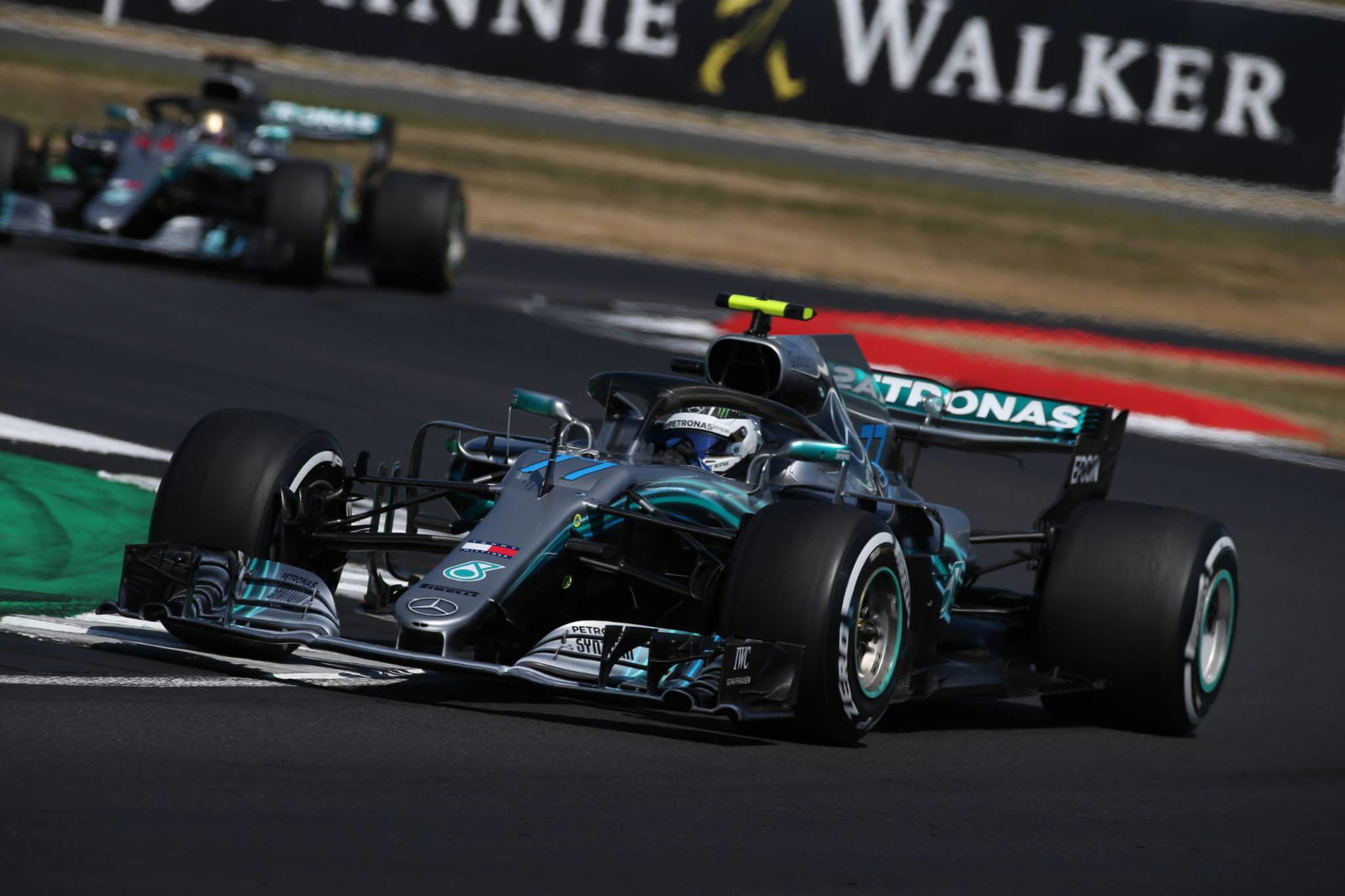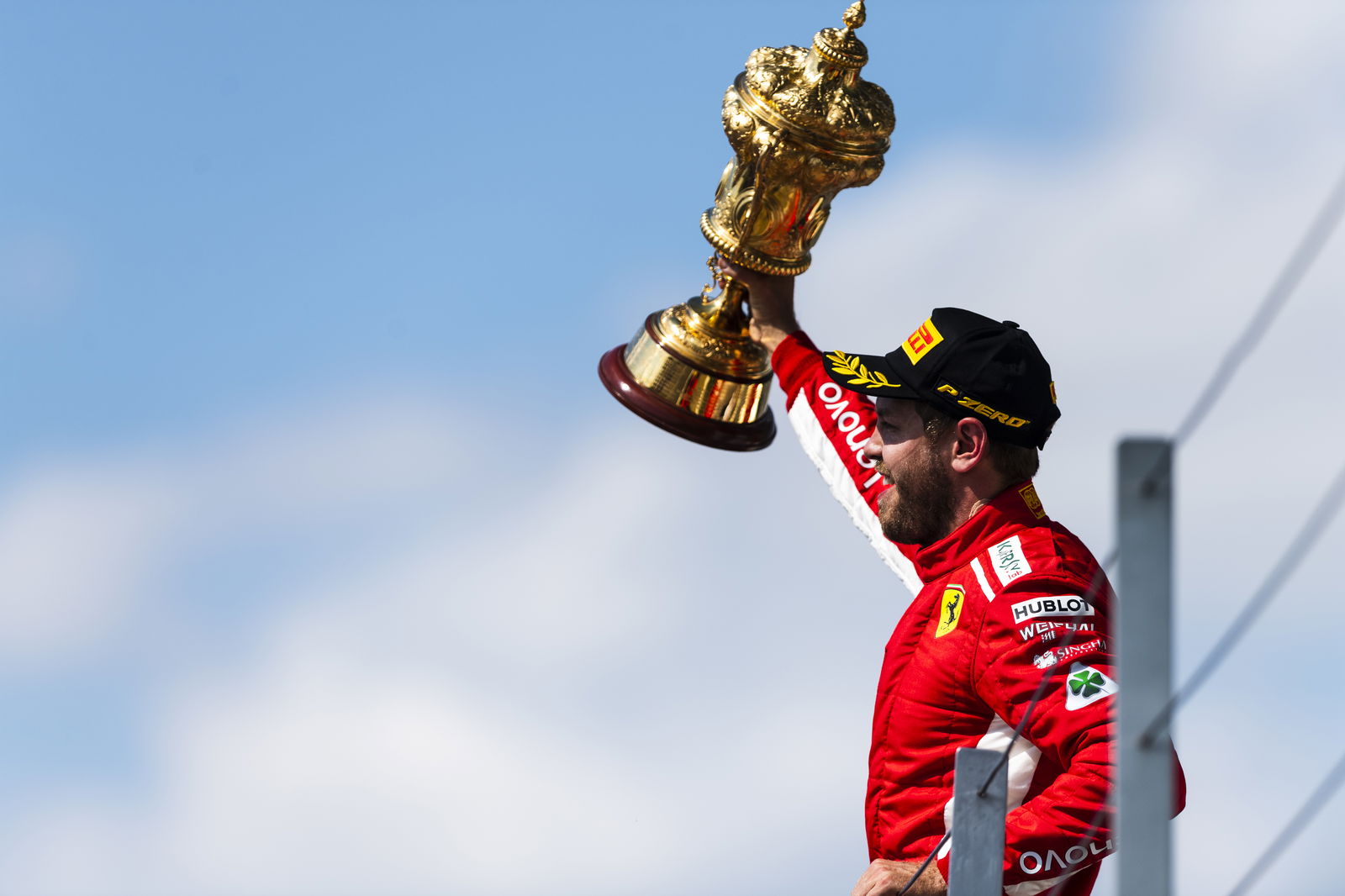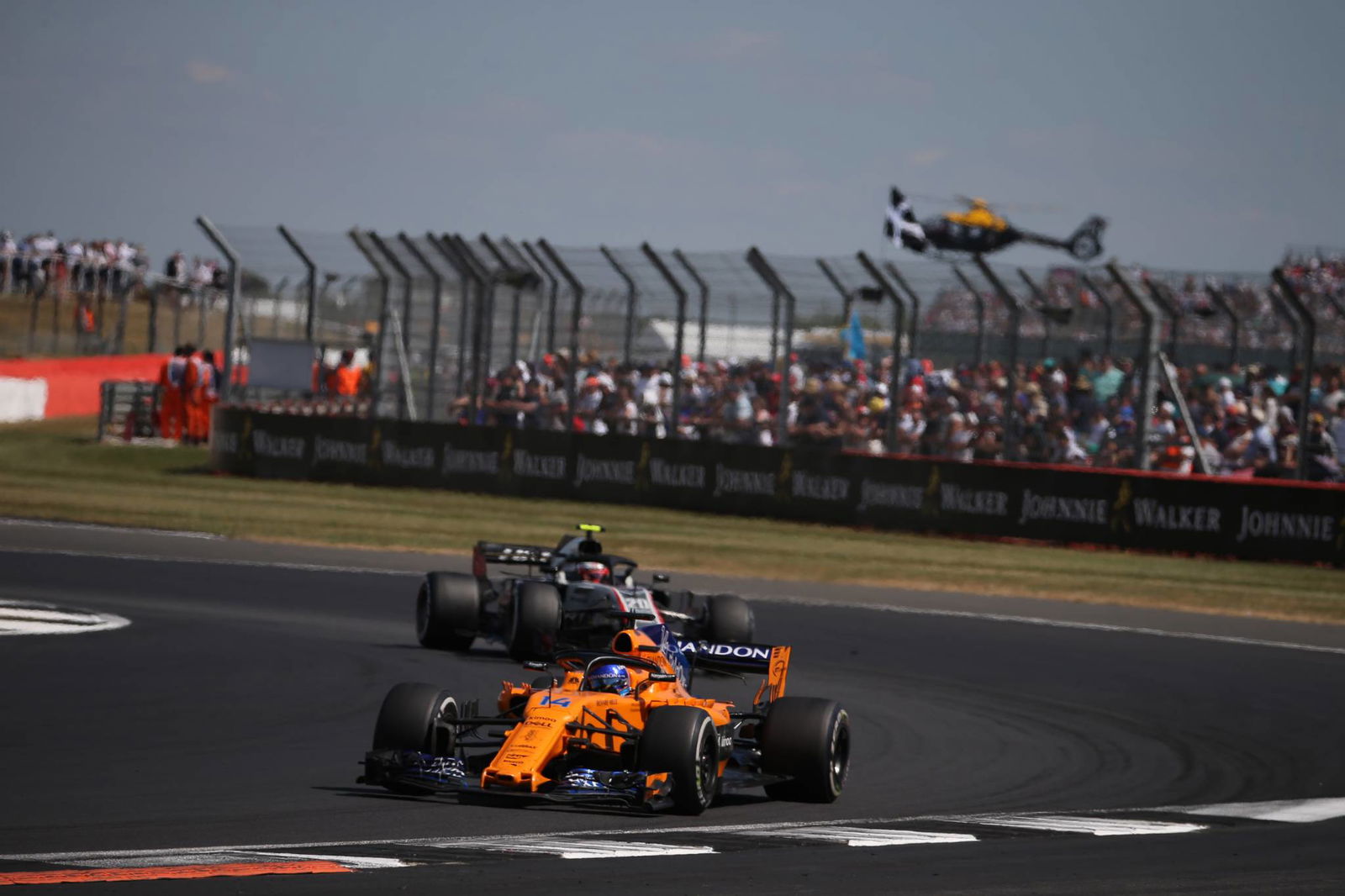F1 Race Analysis: How Ferrari rained on Hamilton’s home parade
There are few things finer than a British sporting summer.
Just as the spirit of the Olympics left the whole country delirious in 2012, thousands of fans who came through the gate for an unusually sunny raceday at Silverstone on Sunday will have been riding high after the England football team’s World Cup quarter-final victory the previous day.
Even the F1 paddock was caught up in the spirit of the occasion, with the exhausted “it’s coming home” slogan emblazoned on a British flag in parc ferme where the victors on Sunday would park up their cars.

There are few things finer than a British sporting summer.
Just as the spirit of the Olympics left the whole country delirious in 2012, thousands of fans who came through the gate for an unusually sunny raceday at Silverstone on Sunday will have been riding high after the England football team’s World Cup quarter-final victory the previous day.
Even the F1 paddock was caught up in the spirit of the occasion, with the exhausted “it’s coming home” slogan emblazoned on a British flag in parc ferme where the victors on Sunday would park up their cars.
Most were expecting Lewis Hamilton to cap off a weekend of highs for British sport in style, such was his record at Silverstone and the excitement surrounding his stunning charge to pole position on Saturday - only for things to unravel quickly on the opening lap, opening the door for Sebastian Vettel to take his second British Grand Prix victory.
The post-race narrative surrounded his clash with Kimi Raikkonen at Turn 3 on the opening lap which scuppered his hopes in an instant, the nature - deliberate? - of the move. But that should not overshadow a phenomenal race that really brought out the very best of F1.
The Lap 1 Clash
Hamilton may have been left in a bitter move as a result of the clash with Raikkonen, yet his critics were quick to point out that he would not have been in a position to get caught up in the incident had it not been for a poor start off the line. Significant wheelspin caused Hamilton to slip behind Vettel at Turn 1 and Mercedes teammate Valtteri Bottas at Turn 2, leaving the door open for Raikkonen to try a move up the inside at the third corner.
Hamilton took a wide line into Turn 3, sweeping across to the apex as Raikkonen tried to steam up the inside. The Ferrari driver locked up - much as Vettel did in France - and proceeded to hit Hamilton, sending him into a spin. Raikkonen was able to continue despite fears of damage to his front wing, while Hamilton was left sitting towards the back of the field.
Post-race, Mercedes team boss Toto Wolff did not hold back in his comments: “It is a lot of constructors’ points… James Allison’s words were ‘do you think it was deliberate or incompetence?’ This is where it leaves us with the judgement.”
Hamilton also hinted at some underhand work from Ferrari, questioning the team’s “interesting tactics” on the podium. “All I’d say is that it’s now two races that the Ferraris have taken out one of the Mercedes,” Hamilton said, elaborating on his comments after the race. “Ultimately it spoils the race. It’s a lot of points that ultimately Valtteri and I have lost in those two scenarios. And, of course, it is a race situation. I couldn’t see behind me but we’ve just to work hard to try to position ourselves better so that we are not exposed to the red cars, because who knows when that’s going to happen again.”
When pressed if he would raise the issue, though, Hamilton said: “No. I don’t have any concerns.” The seed has nevertheless been sown.
One of the biggest post-race questions was why the penalty for Raikkonen was 10 seconds when Vettel had only received five seconds for a similar incident at Paul Ricard. FIA race director Charlie Whiting said it was a question for the stewards to answer, but in short, it seems the aftereffects of the clashes were compared. Whereas Vettel also had damage and was forced to pit in France, Raikkonen managed to continue out on-track. His race had not been compromised in the same way.
Both Vettel and Raikkonen dismissed suggestions of deliberate actions after the race. The similarities between the incidents perhaps made it a question worth asking - but in reality, racing incidents like these happen. The severity of the penalties is perhaps something Hamilton needs to raise with the relevant parties, with Wolff suggesting post-race the stewards could do with a greater range of penalties besides the 5s/10s/drive-through/stop-go options they have at the moment.
Regardless, this is an incident that has added fuel to the fire in the battle between Mercedes and Ferrari this year.

Bottas’ fightback
Following the opening lap shenanigans, the race seemed to be falling into Vettel’s hands quite nicely. He steamed clear in the opening stages, holding a lead of over three seconds after just two laps. The gap extended out to as much as six seconds prior to Vettel’s pit stop at the end of Lap 20, with Bottas reacting one lap later.
A quicker turnaround from Mercedes and some rapid work from Bottas on his in-lap and out-lap saw the gap fall by two seconds before the Finn began to make inroads on the Medium compound tyre. We’ve seen on a number of occasions this year just how strong Mercedes is on the Mediums, no more so than in Bahrain when Bottas and Hamilton both made up heaps of time on the Soft-shod Vettel. The Ferrari man felt things were always under control at the front, though, despite the gap shrinking to as little as two seconds.
“I think in the first stint it was crucial to open the gap, which we did,” Vettel said. “And then in the end, I think Valtteri’s tyres were a little bit in better shape but in the second stint we were largely controlling and I think it would have been fine until the end.”
Bottas was not the only Mercedes driver on the charge through this period, with Hamilton carving through the field with relative ease, highlighting the pace difference between the ‘big three’ and the rest of the pack. None of Hamilton’s overtakes were particularly brave or bold, just routine. After being classified 17th at the end of the opening lap, he was back into P6 by the end of Lap 10. But even with the pit stop cycle shaking out at the front and Hamilton himself completing a switch to Mediums, the gap to the front still stood at 28 seconds, 12 back from Raikkonen even after taking his penalty. If he wanted a podium, he’d need a slice of good luck - which is what the Safety Car seemed to offer.
A chance to capitalise
The usage of DRS through Turn 1 had been debated throughout the race weekend, with Marcus Ericsson becoming the latest driver to fall foul of forgetting to close the flap. Ericsson said after the race that in his efforts to try and extend the DRS usage for as long as possible, he may have hit a bump which caused his finger to slip, meaning when he turned in for the corner, the back-end of the car became loose, sending the Sauber into the wall at speed.
Ericsson was thankfully unharmed, but the shunt nevertheless warranted a Safety Car period that gave Mercedes a chance to capitalise. Given the advantage of sitting behind the Ferrari drivers, both Bottas and Hamilton could respond depending on what their rivals did. Ferrari drafted Vettel in from the lead for a fresh set of Softs; Bottas stayed out. Raikkonen came in; Hamilton stayed out. The Mediums were expected to last to the end, meaning that with Bottas in the lead, a Silver Arrows victory looked possible once again.
A second Safety Car called not long after the restart following a clash between Romain Grosjean and Carlos Sainz Jr. at Copse meant Bottas was able to whittle down a few more laps without pressure from Vettel. While the Finn felt it was just a matter of time until he got passed, he was glad Mercedes tried and failed instead of not giving it a go.
“I think without the Safety Car, of course it's only guessing, but at that point, just before when it came, it felt like our pace was quite strong compared to Ferrari,” Bottas explained.
“I was closing on Sebastian, and we had an advantage at the end of the first stint,The second stint was going to be very long for both of us. We took the risk to stay out to try and win the race, because on-track it's always more difficult with a similar car.
“Honestly, at that point when we stayed out, if the team would have asked me if I wanted to try and go for the win or secure second place, for sure I would have gone for the win.
“But now looking back, for sure, the result would have been better stopping. That's a fact.”
Vettel’s surprise attack
The final 11 laps to the flag would do much to prove just how strong Ferrari has grown in 2018. Whereas this has always been a Mercedes track through the V6 hybrid era, Vettel at last had the chance to grab victory. It wasn’t clear just how much of a tyre drop-off there would be on the Mediums, giving Bottas a real shot at the win, while Hamilton had been lapping as much as 1.5 seconds quicker than Vettel in the lead-up to the Safety Car being called.
It soon became clear just how much of a boost the fresh Softs offered Vettel as he crawled all over the back of Bottas. But the Mercedes driver wasn’t going down without a fight. He boldly defended at Brooklands to see off Vettel’s first attempt, with the German trying a lap later at Luffield, only for Bottas to position his car perfectly to retain the lead, forcing his rival to bail out of a look-in at Copse. Hamilton and - even after his penalty and a second pit stop - Raikkonen were now closing in as well.
Vettel sensed his chance with five laps to go, leaving it late to throw it up the inside of Bottas as Brooklands. For the second time in seven days, Vettel had made a bold yet brilliant pass on a Mercedes driver.
“I had the advantage on the tyres but he had the clean air, so in the high speed stuff I was able to follow, but it was difficult the closer I got,” Vettel explained.
“I saw sort of sniffed my chance already and the first laps after the restart out of Turn 4 and then on the Wellington Straight down to Turn 4. The final move, obviously I was able to surprise him so I think he thought that I won’t dare go on the inside and the braking zone was coming quite fast.
“I felt great when I was side by side, and I wasn’t sure if I would make the cornerm but I did. It was crucial, it wasn’t easy, they seemed to be very strong on the straights, the mid part of the straights.
“With DRS and a tow, I was a bit stronger at the end of the straights so it worked. The main thing is that it worked. It felt great.”

“He started getting really close and I had to push every lap like a qualifying lap,” Bottas added. “I think it was about five laps before the end, it was like driving on ice, I started to lose all grip, especially from the rear end. The traction was getting weaker. That's why he was getting close to me out of slow-speed corners and getting DRS. I was really trying everything I could to defend, but it was really a matter of time.”
Bottas’ woes meant he was powerless to stop both Hamilton and Raikkonen battling past in the closing stages. For his teammate, it meant there was a good level of damage limitation, with Vettel only pulling seven points further clear in the drivers’ championship. From the back of the pack to second was a job well done.
“To get back to second it’s huge for us and I will definitely take it, of course,” Hamilton said. “I’m happy with the drive that I did and what the team were able to do. We’ve just got to work harder.”
And yet there will be a big part of Hamilton that will feel this race was his to win. He made mention of the England football team in the post-race press conference, as he has done for much of the past couple of weeks. National pride is a big thing. His victory was a missing puzzle piece from a perfect sporting weekend.
Whatever your view on the Turn 3 incident, it should not detract from a sublime display from Sebastian Vettel at the front for Ferrari. It was a race win he had to fight hard for. It may not have fitted the narrative of a weekend of British sporting success, but nevertheless, it should be recognised and applauded.
It also sets things up perfectly for the return fixture at Hockenheim in two weeks’ time. Vettel is eight points clear and picking up momentum nearing the summer break, something he was lacking after his early clash with Bottas at Paul Ricard. The tables have turned in the title race - but will it last?


